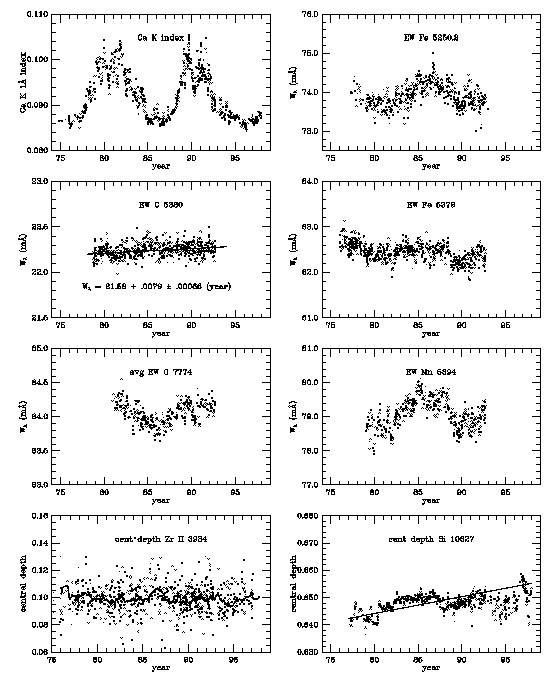
The archives were remarkably homogeneous until a grating change in 1993. This modification resulted in a larger grating which sampled the solar disk light in a slightly different way. Introduced was an irrecoverable glitch in the time series, especially for the weaker photospheric lines.
Most of the solar cycle variation can be attributed to surface magnetic flux that presumably originates in active regions and is distributed over the disk as plage, faculae, and the network. There may be other factors which cause line strength change. These are the subject of current research. There is some evidence of line variability that extends beyond the 11 year activity cycle.

FIGURE 1: Lines which display the greatest cycle modulation.
Figure 2 reports on the behavior of several photospheric lines including the high excitation line of C 5380. Another maverick is the oxygen triplet at 7774 whose intensity is out of phase with other lines. The rare earth lines of Zr II 3934 and Ce II 3967 in the wings of H and K do not vary sensibly (or their variation is in the noise). Of special interest to us is the strong line of Si 10827. Because this wavelength is located in the 2nd order the grating angle is small and grating illumination is unvignetted in both the old and new systems; there is no 1993 break.

FIGURE 2: Lines which have little or no cyclic component, or which differ in phase from those in Figure 1.
Participants in this project have included Y.-R. Huang, Z. Liu, S. Meng, C. Mahaffey, M. Steffen, Y. Wang, and B. Ye.
White, O.R. & Livingston W.C. 1978, ApJ, 226, 679
White, O.R. & Livingston W.C. 1981, ApJ, 249, 798
Livingston W.C. & Wallace, L. 1987, ApJ, 314, 808
Gray, D.F. & Livingston, W. C. 1997, ApJ, 474, 802